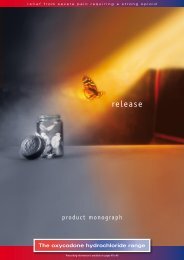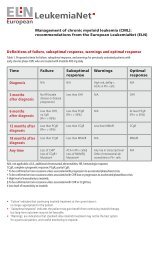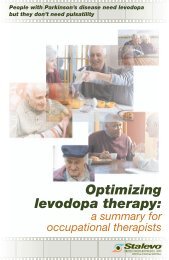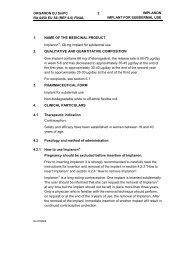Product Monograph - epgonline.org
Product Monograph - epgonline.org
Product Monograph - epgonline.org
Create successful ePaper yourself
Turn your PDF publications into a flip-book with our unique Google optimized e-Paper software.
Contents<br />
5<br />
Acceptability 19<br />
1<br />
Introduction<br />
5.1 Bleeding pattern 19<br />
Terminology 20<br />
Bleeding patterns in starters and switchers 20<br />
Trends over time 22<br />
Bleeding pattern in breast-feeding women 24<br />
Discontinuation related to changes in bleeding<br />
pattern 25<br />
5.2 Subjective adverse events 26<br />
Dysmenorrhea 27<br />
Acne 27<br />
5.3 Effect on body weight 28<br />
5.4 Follicle enlargement 28<br />
5.5 Discontinuation related to adverse events 29<br />
5.6 Summary 29<br />
6<br />
Use during lactation 31<br />
6.1 Summary 32<br />
7<br />
Safety aspects 35<br />
7.1 Lipid metabolism 35<br />
7.2 Carbohydrate metabolism 37<br />
7.3 Hemostasis 37<br />
7.4 Blood pressure 40<br />
7.5 Liver enzymes 40<br />
7.6 Effects on other physiological systems 40<br />
7.7 Summary 41<br />
8<br />
9<br />
10<br />
Summary 43<br />
References 45<br />
Summary of product characteristics 53<br />
Combined oral<br />
contraceptives<br />
(COCs)<br />
Progestogen-only<br />
pills (POPs)<br />
The most popular form of reversible contraception in use today<br />
is the combined oral contraceptive (COC). However, while COCs<br />
are highly effective, the estrogen component is dose-dependently<br />
associated with a wide range of adverse events that precludes<br />
their use in certain women (Guillebaud 1993). The main<br />
concern with COCs is the demonstrated association with venous<br />
thromboembolism (Gerstman et al. 1991; Helmrich et al. 1987;<br />
Thorogood et al. 1992; Vessey et al. 1986). Furthermore,<br />
although myocardial infarction (MI) and stroke are less common<br />
with today’s low-dose COCs than with earlier formulations<br />
(Carr and Ory 1997; Godsland and Crook 1996; Lidegaard et al.<br />
2002; Rosenberg et al. 1997), there is still a slightly increased<br />
relative risk of MI in smokers over 35 years of age, and of stroke<br />
in women who smoke or who have high blood pressure (Carr and<br />
Ory 1997; Godsland and Crook 1996; Rosenberg et al. 1997).<br />
COCs are therefore unsuitable for women with risk factors for<br />
arterial and venous thrombosis (Alving and Comp 1992;<br />
Guillebaud 1993; Machin et al. 1995).<br />
Even in women with no apparent contraindications, the use of<br />
estrogens may be associated with “nuisance” adverse events,<br />
such as nausea, headache and breast tenderness, which are<br />
important reasons for women to discontinue use of COCs. The<br />
use of estrogens can also adversely affect the quantity and<br />
composition of breast milk in lactating women.<br />
Progestogen-only pills (POPs) are a suitable alternative to COCs.<br />
However, the majority of the currently available POPs also have<br />
some important disadvantages. First, they do not suppress<br />
ovulation consistently, but instead rely largely on their effects on<br />
the cervical mucus for contraceptive activity. This is the reason for<br />
the 3-hour intake window of traditional POPs and their reduced<br />
contraceptive efficacy. Moreover, as progestogens slow transport<br />
of the ovum along the fallopian tubes (McCann and Potter 1994),<br />
POPs are associated with an increased risk of ectopic pregnancy<br />
compared to COCs because they do not consistently inhibit<br />
ovulation. Second, POPs have variable effects on the<br />
endometrium, resulting in an unpredictable vaginal bleeding<br />
pattern, and this often results in their discontinuation. Third, the<br />
1
















